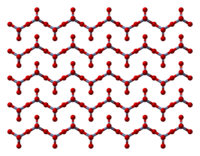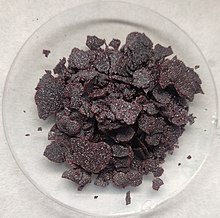 | |

| |
| Names | |
|---|---|
| IUPAC name
Chromium trioxide
| |
| Other names
Chromic anhydride, Chromium(VI) oxide, Chromic acid (misnomer)
| |
| Identifiers | |
3D model (JSmol)
|
|
| ChEBI | |
| ChemSpider | |
| ECHA InfoCard | 100.014.189 |
PubChem CID
|
|
| RTECS number |
|
| UNII | |
| UN number | 1463 |
CompTox Dashboard (EPA)
|
|
| |
| |
| Properties | |
| CrO3 | |
| Molar mass | 99.993 g·mol−1 |
| Appearance | Dark red granular solid, deliquescent |
| Odor | Odorless |
| Density | 2.7 g/cm3 (20 °C)[1] |
| Melting point | 197 °C (387 °F; 470 K)[1] |
| Boiling point | 250 °C (482 °F; 523 K) decomposes[1] |
| Solubility | Soluble in H2SO4, HNO3, (CH3CH2)2O, CH3COOH, (CH3)2CO |
| +40·10−6 cm3/mol[1] | |
| Thermochemistry | |
Std molar
entropy (S⦵298) |
73.2 J/(mol·K)[3] |
Std enthalpy of
formation (ΔfH⦵298) |
−589.3 kJ/mol[4] |
| Hazards | |
| GHS labelling: | |
     [5] [5]
| |
| Danger | |
| H271, H301+H311, H314, H317, H330, H334, H335, H340, H350, H361f, H372, H410[5] | |
| P210, P260, P280, P303+P361+P353, P304+P340+P310, P305+P351+P338[5] | |
| NFPA 704 (fire diamond) | |
| Lethal dose or concentration (LD, LC): | |
LD50 (median dose)
|
80 mg/kg (rats, oral)[6] |
| Safety data sheet (SDS) | ICSC 1194 |
Except where otherwise noted, data are given for materials in their standard state (at 25 °C [77 °F], 100 kPa).
| |
Chromium trioxide (also known as chromium(VI) oxide or chromic anhydride) is an inorganic compound with the formula CrO3. It is the acidic anhydride of chromic acid, and is sometimes marketed under the same name.[6] This compound is a dark-purple solid under anhydrous conditions and bright orange when wet. The substance dissolves in water accompanied by hydrolysis.[clarification needed] Millions of kilograms are produced annually, mainly for electroplating.[7] Chromium trioxide is a powerful oxidiser, a mutagen, and a carcinogen.[8]
- ^ a b c d e Lide, David R., ed. (2009). CRC Handbook of Chemistry and Physics (90th ed.). Boca Raton, Florida: CRC Press. ISBN 978-1-4200-9084-0.
- ^ Seidell, Atherton; Linke, William F. (1919). Solubilities of Inorganic and Organic Compounds (2nd ed.). D. Van Nostrand Company. p. 250.
- ^ "chromium(VI) oxide". chemister.ru.
- ^ Pradyot, Patnaik (2003). Handbook of Inorganic Chemicals. The McGraw-Hill Companies, Inc. ISBN 0-07-049439-8.
- ^ a b c Sigma-Aldrich Co., Chromium(VI) oxide. Retrieved on 2021-11-22.
- ^ a b c "Chromium trioxide". chemicalland21.com. AroKor Holdings Inc. Retrieved 2014-06-15.
- ^ Anger, G.; Halstenberg, J.; Hochgeschwender, K.; Scherhag, C.; Korallus, U.; Knopf, H.; Schmidt, P.; Ohlinger, M. (2000). "Chromium Compounds". Ullmann's Encyclopedia of Industrial Chemistry. doi:10.1002/14356007.a07_067. ISBN 3527306730.
- ^ Mamyrbaev, Arstan Abdramanovich; Dzharkenov, Timur Agataevich; Imangazina, Zina Amangalievna; Satybaldieva, Umit Abulkhairovna (2015-04-16). "Mutagenic and carcinogenic actions of chromium and its compounds". Environmental Health and Preventive Medicine. 20 (3). Springer Science and Business Media LLC: 159–167. doi:10.1007/s12199-015-0458-2. ISSN 1342-078X. PMC 4434237. PMID 25877777.
